‘Crossroads 2015. Human cities_challenging the city scale’ is a creative workshop organized by Cité du design for the Human Cities program during the Biennale Internationale Design Saint-Etienne 2015. Focused on the conversion of vacant shops and ground floor premises in the Jacquard district, it will bring together local skateholders, designers and international networks . It will be animated by the Carton Plein association, which occupies B.E.A.U. – the temporary urban action office during the Biennial. Carton Plein leads an atypical study in connection with the planners of the city, partners of the EPASE project – Etablissement Public of Saint-Etienne – in order to imagine collectively different scenarios to initiate new dynamics in the neighbourhood. The aim of the workshop is to try to stimulate the emergence of new services, new ways of investing spaces and new ways of inhabiting and living in them. The keys to get a district moving and to bring life to its streets for cities and towns are in their human capital, creativity and design.
“Crossroads 2015” will show how design tools – such as prototyping, script and visualisation – can help to invent new urbanistic tools where creativity is at the service of innovation in the territories. It will create also a dynamic network between the members of Human Cities and the UNESCO Creative Cities of Design network invited by Saint-Etienne, by a collaborative experimentation.
“Crossroads 2015” is also the gathering moment of the 2 main international workshops of Biennale International Design Saint-Etienne : “Human Cities” and “All Champions-People Olympics”: 2 initiatives focused on collaborative experimentation to make an active, creative, vivid city.
Human Cities_Challenging the City Scale/Milano will run two Experiment Labs to involve visitors, citizens and the representatives of the 11 partners to “challenge the city scale”.
The first Experiment Lab will take place at BASE during the exhibition of Human Cities_Challenging the City Scale/Milano starting from the design experience of the Masterclass “Temporary Urban Solutions”. Two of the best actions developed by the students and the local associations will be put on place: how to upcycle second hand objects into an urban setting and how to hack abandoned public space with acupunctural playgrounds.
The second Experiment Lab will take place @LaPiana. It will involve all the representative of the 11 partners in several activities in direct contact with the local associations and the public space of La Piana. It will be the chance to get in touch with the theatre, the neighbourhood, to explore the context and to experiment this local urban reality in Milan.
This conference is part of the initiative of Human Cities 2014-2018 program. Organized by the Cité du design, this conference was about the workshop and the idea of Crossroads 2015, part of the Biennale Internationale Design Saint-Etienne 2015 program. It took place on 17 March 2015 from 5 PM until 8 PM at Cité du design , and gathered the international workshops “Human Cities” and “All Champions-People Olympics”, and their relative participants from international networks : Human Cities, UNESCO Creative Cities Network, Living Labs, People Olympics.
Keynote speaker Charles Landry, researcher, inventor of the “Creative Cities” concept was invited to give his expert point of you on these initiatives using design to make a more active and human creative cities. European Commission expert Marc-Hector Vanderhaegen introduced the Creative Europe Program, framework of Human Cities 2014-2018 project.
With State of the Art as its first theme, Human Cities: Challenging the City Scale aims to set up a common ground in tackling the issue of how people challenge the urban scale and flow in Europe today.”
The Human Cities partnership is currently reviewing different case studies that contribute to rethinking and reactivating public space in contemporary European cities. With a bottom-up approach – projects initiated and run by the civic society groups – these case studies describe and explain how people organise themselves in specific territories, to question local issues and to see how ideas evolve (or not) out of these environments to influence the city on multiple levels.
During the Milan Design Week, Human Cities presents “Human Cities_Challenging the City Scale/Milano”, an interactive exhibition in a 500 sqm space at BASE Milano (Via Bergognone 34, Milano) during the Milan Design Week, April 12th-17th 2016.
The event is the first stage of a traveling exhibition across Europe: in the next 3 years, all the partners will exhibit the work in progress of the research. This is a wandering path, an itinerant circus sets up in the partners cities to show how they are “challenging the city scale”, like a continuous experience in different places and contexts where everything is connected to compose the story of all the experiences .
It will be an itinerary, a path throughout Europe, a way to tell how we are “challenging the scale”. A wandering circus to be settled in the partners cities.
The Circus will be the main concept of the exhibition: as a continuous experience place by place and as a suspension like an acrobat in, a place without space-time. The exhibition during Human Cities Challenging the city Scale/Milano will be focused on the equilibrium inside the circus where everything is connected to create a story of all the experiences together.
During the exhibition there will be an on-going Experiment Lab where people could interact and activate the space. The exhibition and the Experiment Lab are results of an active design experience between Politecnico di Milano – Design Department and School of Design, with “Atir Ringhiera” theatre in Milan and 11 local associations around “La Piana”, a square of 6000 sqm in front of the theatre. This design experience took place during the Masterclass “Temporary Urban Solutions”, where 62 international students from more than 10 different countries worked for 5 months to develop spaces and services which could reactivate “La Piana”.
“Human Cities_Challenging the City Scale/Milano” will host the College of Design and Innovation of Tongji University – Shanghai, showing the research projects done in an extra-european urban contexts and in collaboration with local organizations: the street food trend, “Open Your Space” involving the Siping Lu’s community, “Design Harvest” in Chongming Island, the biomimicry, the community FabLab(s).
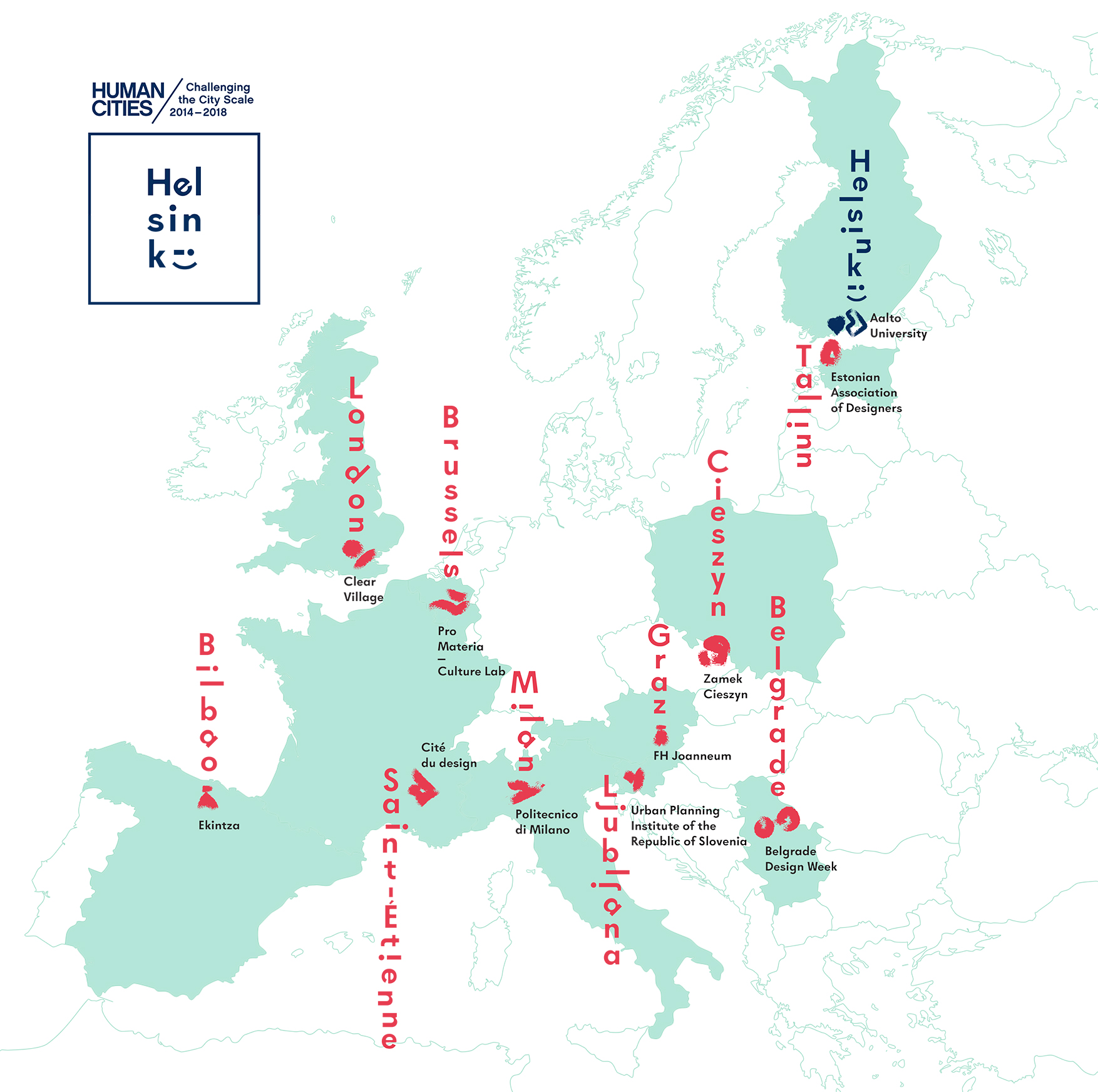
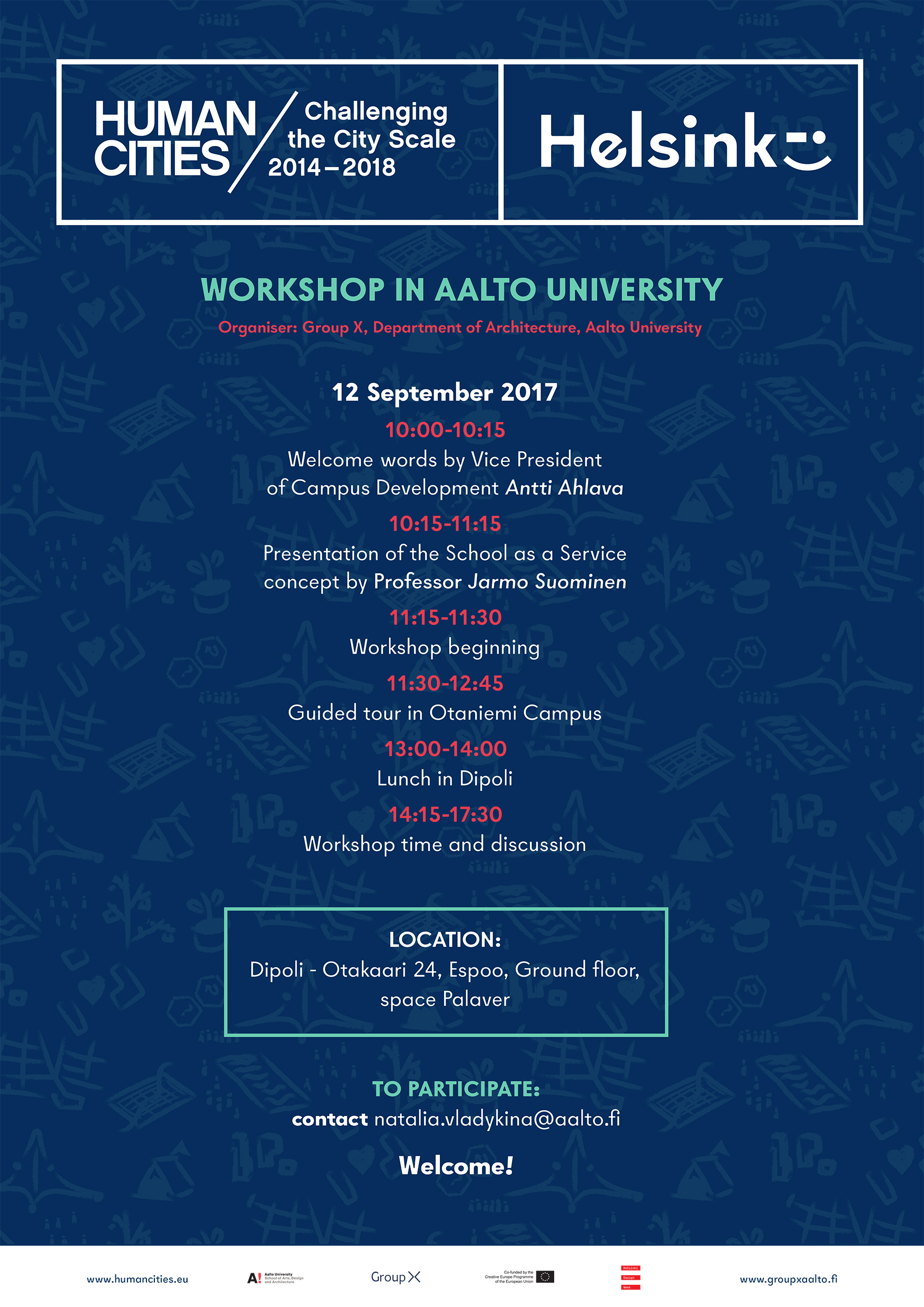
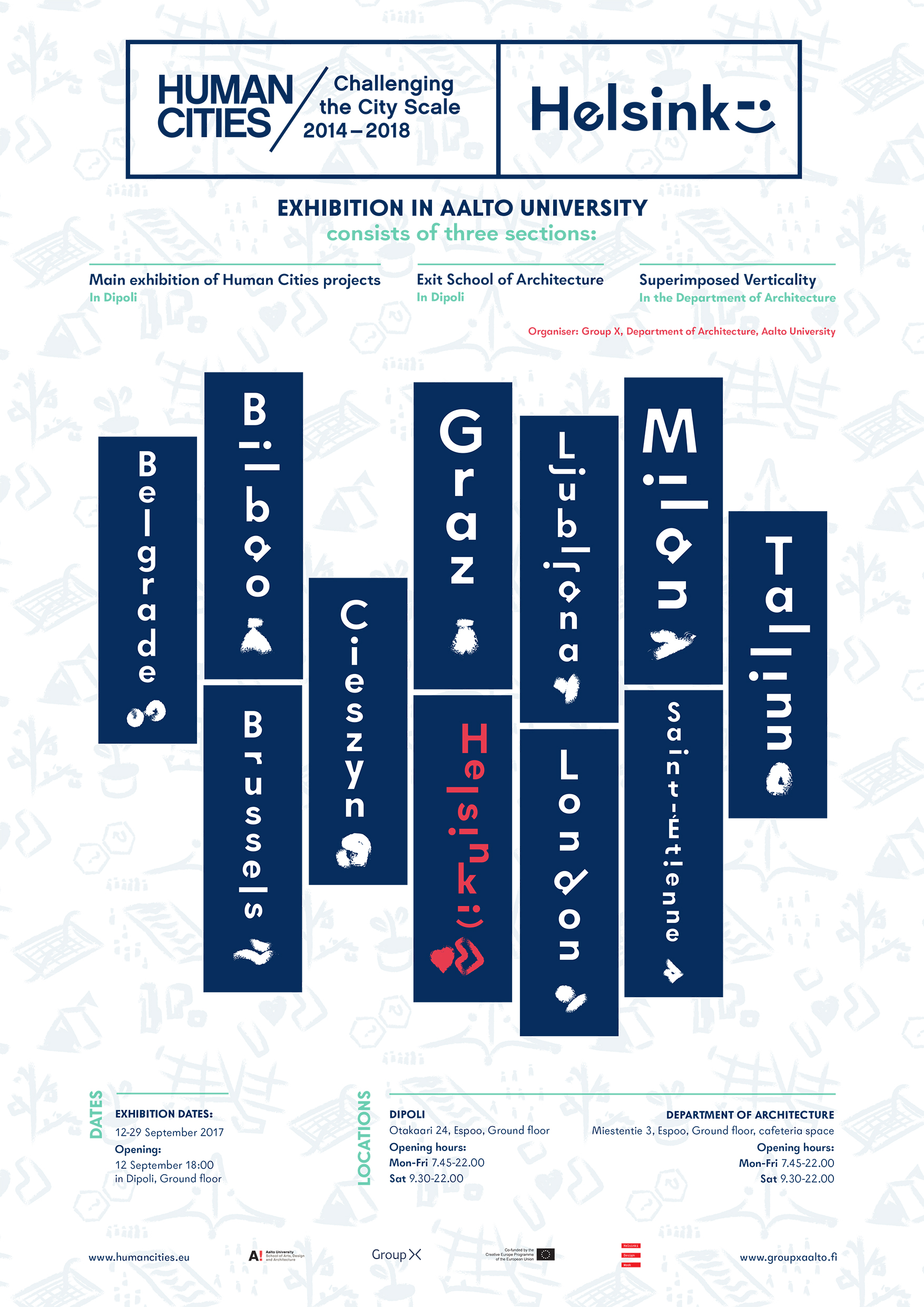
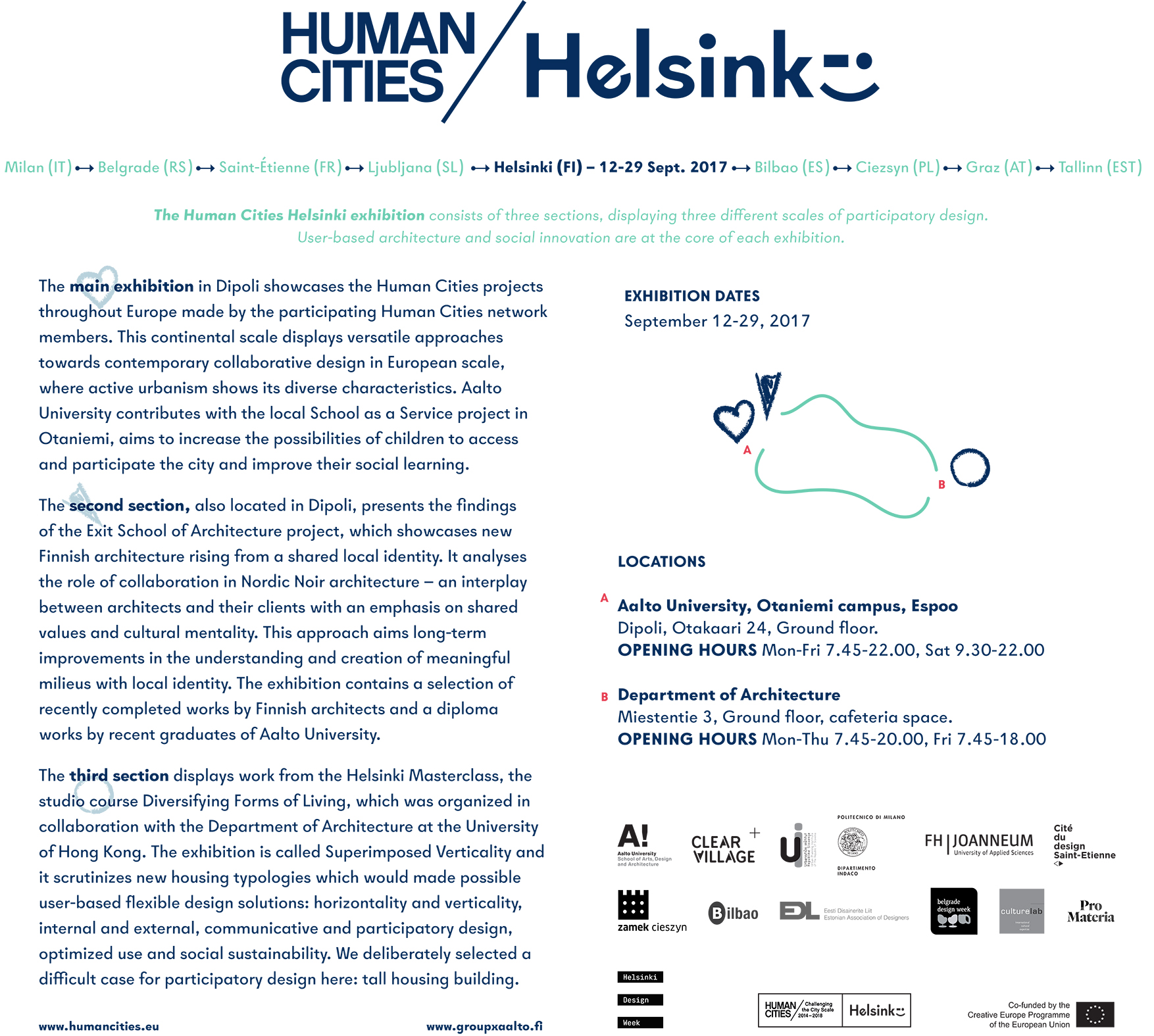
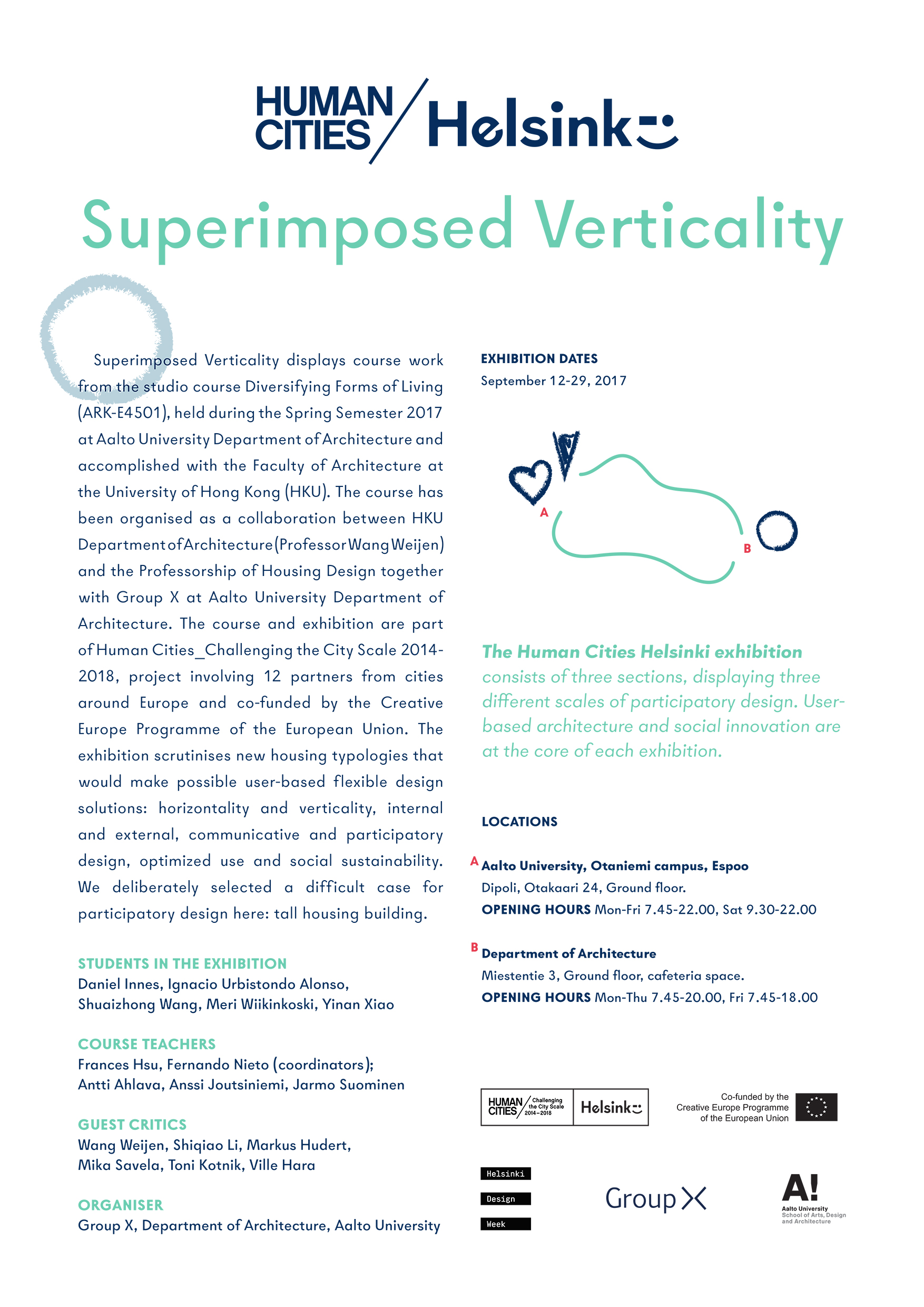
Co-School. Experimentation Labs. Rethinking Learning
Jarmo Suominen, Antti Ahlava, Pekka Tynkkynen, Fernando Nieto
Co-creation process with schoolchildren and teachers, two studio courses, one design workshop and a concrete building and renewal project
In collaboration with RCA Service Design and Tongji University
Human Cities_Challenging the City Scale 2014-2018. Co-funded by the Creative Europe Programme of the European Union
Video credits
Reporter and editor: Eini Nyman
Camera: Silja Ylitalo, Eini Nyman
Music: Setuniman @ freesound.org
Introduction
The co-briefing session is about getting knowledge about the spatial and social context for the masterclass and experimentation lab by focusing on a place called “La Piana”, a 6000mq empty square in front of an independent and sparkling theatre in the south part Milan, Teatro Ringhiera.
Context
The Ringhiera theatre is run by an association called Atir that has been very interactive with neighbourhood in the last years organizing a lot of community engagement activities in the public spaces in front of the theatre main entrance.
Since “Atir” began to manage the theatre in 2007, a strong dialogue started with the neighborhood, the local associations and the administration in order to activate and to open up the public space of the theatre to the city. There are hidden spaces, not because hidden from the public, but as they relate to historical memory and are no longer traced to contemporary places: this is the case of the Boifava neighbourhood, located on the edge of the attractive area of the Navigli – a dense urban one – and the Parco Agricolo Sud – a protected rural area in the south of Milan.
How to make La Piana the point of connection between these two typical Milan peculiarities? How to activate this place through services and actions? How to “put on stage” the citizens stories related to La Piana?
Since 2014, the theatre – thanks to its Social Program – organized the Street Art Festival http://www.atirteatroringhiera.it/pagina.php?id=33, asking international artist to re-design the “piazzale” through temporary works of art, performances and installations. The artistic process involves citizens and the local community in a sort of “composition game”, starting from collecting inhabitants needs and desires until co-construction phases, with the collaboration of institutions and administration.
The collaboration between the theatre and the research team at Politecnico was established to enhance the relationship between the citizens and the space by using design approach, tools and output.
Co-briefing session
On October 14th and 15th, a co-briefing session was done coordinate by Alice Holmberg and with the participation of Davide Fassi (Associate Professor- Politecnico di Milano), Laura Galluzzo (Fellow researcher, Politecnico di Milano), Daniela Selloni (Fellow Researcher, Politecnico di Milano), Annalinda De Rosa (PhD candidate, Politecnico di Milano), Maria Spazzi (ATIR association), Nina Bassoli (ATIR association). The session was divided in two parts:
– Day 1, 14.10.2015 at Teatro Ringhiera, Milan
During the first day two main activities were done: in-the field visit of the area and “indoor interviews” to the participants to frame the works to be done. We also discussed the measuring element and that in terms if Human Cities, it would be relevant to streamline the methods for monitoring and evaluation.
– Day 2, 15.10.2015 at POLIMI DESIS Lab, Design Department, Politecnico di Milano
The second day was more aimed at defining some milestones to build a brief on. According to the “indoor interviews” done, we focused the attention to “tools” and “legacy”, or how to share some tools to be used even by other partners and how to be effective in long term after the experimentation lab end, creating legacy in between the lab results and the future of the space.
> Challenges, potential and possible scope for the experimentation: Use optimization of the built environment through the project “School as a Service” at Aalto University’s campus in Otaniemi, Espoo (Finland). It consists of the creation of a new temporary school in Otaniemi for those schoolchildren whose own school is under reparation, based on service design thinking rather than product design
> Aesthetic context:
– Helsinki School of Architecture’s positioning in relation to Helsinki School of Photography and their distinctively Nordic ambience
– Cultural consciousness, in contrary to the often built-in visual obsolescence of ex. pop-up graphics
– Traditional Nordic design values and Aalto’s values of affordable, high quality good design, promoting democratic access to good value
> Partners:
– City of Espoo
– Design Factory – Startup Sauna – Urban Mill
– Aalto ARTS
> Main topics:
– Holistic approach to building
– Diversity of uses
– Sustainability statement
– Definition of Nordic ambience
> Theoretical work:
– Critical assessment of the terminology around “human”. What is the concept “human” in Human Cities?
– Paper “Happy together vs melancholy of loneliness. Disruptive practices on community and privacy”
> Discussion:
– Prototype the service operator: create accessibility to space and redefine the space ecosystem
– Access in service design
– Define overlapping spaces and overlapping uses of spaces
– Reach out to possible new stakeholders
– Create an OS (operating system) for optimised spaces
– Branding and aesthetics, benchmarks are local adaptation – reacting to context, durable design, meaningful, inspiring, creating interactions, colourful, sustainable, furniture ownership by the users, turn the uses inside-out
– Hosting + reception + interaction = adaptive business model
> Attendees: Alice Holmberg, Antti Ahlava, Jarmo Suominen, Fernando Nieto, Pekka Tynkkynen, Mia Hertsberg
The Cité du Design will lead various experimentations on Saint-Etienne territory in 2015-2017. One of the topics is to tackle the retails and street level spaces. In the contemporary urban context, the classic city, with its town center and its suburbs, disappears to make way for a world of networks, connections, of multi- polarity. The flows of traffic – carried by land, sea or digital routes, take over from places. These structural evolutions are impacting both people and spaces , like the shops in the city centres. How to invent innovative proposals to activate these spaces and scales ?
The first action of C.H.O.S.E is to launch a call for initiatives for local actors in order to establish an experimental program in 2016 – 2017 (see calendar below)
The result of this call for initiatives was very rich: 4 local actors came forward and presented their initiatives.
Recent updates:
We have met these four groups of actors collectively and individually which was the opportunity for them to present themselves, their initiatives but also their visions and goals.
During those meetings we discussed the details of their initiatives and we debated and reflected upon ways to mix their know-hows and cross-disciplinary approaches to challenge the urban transformations in Saint-Etienne!
Our next meeting is planned for the end of April and the goal is to see how exactly the experimentations will take place!
Human Cities_Challenging the City Scale/Milano will host the Human Cities annual meeting involving more than 30 participants from the 11 partners.
The meeting will be an opportunity to share how the European cities involved in the programme, are activating public spaces, to schedule the future steps, to promote the activities of the network through a seminar, to deep dive into the Experiment lab at “La Piana” and to visit key public places in Milan.
PROGRAMME:
April 12th-17th//HUMAN CITIES EXHIBITION/ MILANO
BASE Milano, Via Bergognone 34, 20144, Milano
April 13th//ANNUAL HUMAN CITIES PARTNERS MEETING
13.00-18.30 in Politecnico di Milano – Bovisa campus, via Candiani 72, Milano
April 14th//LAB
10.00-11.00 Visit to exhibition + Experiment Lab @BASE Milano, Via Bergognone 34, 20144, Milano
11.00-12.30 Human cities Seminar @BASE Milano, Via Bergognone 34, 20144, Milano
12.30 Exhibition Opening @BASE Milano, Via Bergognone 34, 20144, Milano
13.30 Bike tour to La Piana (Teatro Ringhiera ATIR), Via Boifava 17, 20142, Milano
14.30-18.00 Experiment Lab @La Piana (Teatro Ringhiera ATIR), Via Boifava 17, 20142, Milano
18.00 Bike tour to BASE Milano, Via Bergognone 34, 20144, Milano
18.30 Event at Triennale Exhibition @BASE Milano, Via Bergognone 34, 20144, Milano
April 15th//TOUR
9.30-13.00 New Public spaces in Milan: guided tour
13.00-14.00 Lunch and end of the activities
The Final Human Cities Challenging the City Scale 2014-2018 event will be held in Tallinn during XIII Tallinn Design Festival. In fact Human Cities is this year’s theme of the festival.
The XIII Tallinn Design Festival will be held from 10 to 16 September 2018. For a week, the unique festival which centres on different parts of Tallinn, will be revived – the historic Baltic Station Departure Pavilion, the new building of EAA, Museum of Architecte, Architectural and Design Gallery, Viru Centre, Telliskivi, Alexela Concert Hall, Solaris, Kadriorg Tennis Hall and dozens of satellites in various locations.
Designers, architects, urbanists, and planners are committed to ensuring a more sustainable and human-friendly urban environment. Insights and testimonials from other cities can be seen at exhibitions and the conference which marks the successful end of the four-year Europe-wide project “Human Cities – Challenging the City Scale”. We are looking forward to presenters from several architectural bureaus and other distinguished visionaries such as Mark Kingwell (Canada), Liam Young (UK) and Chantal Vanoeteren (Belgium). Those interested in urban development can see projects from 11 different countries, including innovative projects of Politecnico di Milano and Aalto University. The Estonian team will present the relaxation capsule HÄLO. The works of the nominees of Germany’s renowned design award IF will complement the exhibition from the perspective of the students. „Human Cities“, a music piece by Villu Veski and Laura will bring the project to an upstanding end.
This year’s design festival will be spiced by an exciting opportunity to get acquainted with the finest Estonian design in Viru Centre. At the festive Design Award gala product design awards BRUNO and SÄSI, graphic design award and prizes in other categories will be awarded.
A graphic designers exhibition „Dialogue“ will also be displayed.
Throughout September in the Museum of Estonian Architecture visitors can become acquainted with the exciting history of Isokon which has accrued from the foreign representation of the Luther factory. The text and pictures of the Isokon Gallery in London are supplemented by product examples from the Luther factory and its descendant, as well as replicas of the Isokon products, supported by the well-known designers from Bauhaus – Walter Gropius, Marcel Breuer, etc.
The exhibition reflecting the plywood industry is brought to the present day by the examples of the plywood manufacturer’s workshop. The topic is complemented by lectures of Jüri Kermik, John Allan and Magnus Englund (Director of the Isokon Gallery Trust). From Hungary, examples of wearable technologies and achievements of digital handicrafts are brought to the Design Festival. Authors are looking for answers on how a traditional craft can continue in today’s digital world without losing value. At the exhibitions of design schools one can examine the developments taken place in different educational institutions during the year, also get acquainted with the student works from Lahti and participate in an experience room Design For All. The festival’s attractions are fashion shows, PechaKucha and Design Street. The light installations show the way to the attractive centres of the Festival, a musician Kristjan Kannukene presents his new single in the tunnel. It is possible to participate at an unconventional tour „Closed Rooms“ and visit places full of surprises you could possibly not get into.
There will be plenty of events for the entire family, including educational workshops for children and workshops “Child Culture Design”